|
|
Entries in thanksgiving (2)
Roasted Butter Herb Turkey
 Wednesday, November 27, 2019 at 6:33PM
Wednesday, November 27, 2019 at 6:33PM 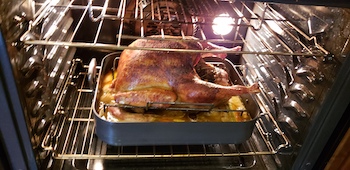 For a number of years my son and I have been refining a turkey recipe that was a traditional cooking approach while adding some spices and staying thoroughly juicy and moist.
For a number of years my son and I have been refining a turkey recipe that was a traditional cooking approach while adding some spices and staying thoroughly juicy and moist.
After trying a few variants of "newer" approaches we settled back into a traditional 3-4 hour bake since we didn't want to go down the routes of brining, deep frying, fast cooking etc. This recipe is one we built, after studying, stealing and melding different things we saw and tried. In the end we just kept what we liked. Over the years, family has given us glowing reviews on taste, juiciness and enjoyment of the meal.
Hope this helps kickoff your own journey of turkey cooking. Below is the recipe in a standard format. Following that is a short pictographical step-by-step preparation sequence which may seem a helpful addition to the recipe information.
Companion Video-Making the Perfect Juicy Turkey - with Kim Gentes.
Two Golden Rules: there are two absolute rules of cooking a turkey that cannot be broken. If you forget everything else below, remember these:
- Internal Temperature. The internal temperature of the turkey is the guide to knowing when the bird is cooked, not the amount of time you are cooking the turkey or the type of oven you have. My goal is to have the internal temp reach 158. Once it does, the turkey is done. (see note 1 below for information on safe temperature and cooking)
- Rest. The turkey should never be cut, carved or opened immediately after taking it out of the oven. It must be rested at least 30 minutes. See more details below.
Roasted Butter Herb Turkey
Ingredients
-
20-25 lb Turkey (thawed), with giblets, neck and liver/heart removed
-
4-6 sticks of butter
-
2 quarts of chicken stock/broth (64 oz)
-
1 large white/yellow onion
-
5/6 whole carrots
-
½ plant of celery
-
½ lemon
-
1 large sprig of Rosemary
-
1 head of garlic
-
4 tablespoons Poultry seasoning (McCormicks or Spice Islands)
-
2 tablespoons Cajun seasoning
-
3 teaspoons of Italian herb seasoning (parsley, oregano, rosemary, sage)
-
2 teaspoons of minced onion flakes
-
3 teaspoons of salt
-
Fresh ground pepper
Preparation
-
Make butter herb paste. Mash the sticks of butter into a paste. Mix in the poultry seasoning, cajun seasoning, herbs, onion flakes and salt. The mixture should be mashed until it is a spreadable paste.
-
Apply paste to turkey. With your hand, loosely lift the skin of the turkey from the body around the breast (trying not to tear it). Fill the entire sub-skin area with the butter paste, as far around the breast, limbs and body as you can. This should leave you with about ⅓ of the paste remaining. Use the remaining paste and completely cover the turkey with it. Add additional salt, pepper, minced herb and cajun spices lightly over turkey. Finally, add more fresh ground pepper over the entire bird.
-
Stock Vegetables. Peel carrots, Chop celery. Cut onion in half. Break garlic into cloves.
-
Place carrots, celery, ½ the onion, and ½ of the garlic into the bottom of the roasting pan. Add giblets, neck and liver/heart to bottom of pan. Pour the 64oz chicken stock to bottom of roasting pan.
-
Place the remaining ½ onion, ½ garlic, the lemon and the rosemary sprig in the cavity of the turkey.
-
-
Roast turkey. Place turkey on roasting rack inside of roasting pan in preheated oven (325℉). Depending on the size of turkey, cook for approx 4 hours until internal temperature reaches 156-160℉1. Once the internal temperature is reached, remove the turkey from the oven. [important: read the next point, so you do not forget to partially cover the bird with foil part way through cooking]
-
Cover top. Depending on the placement of heating elements in your oven, at about 1.5-2 hours into the bake of the turkey monitor the top of the turkey. Once the top has crisped and browned, gently lay a "hat" of foil over the top of the turkey to prevent the skin from crisping so far that it cracks or over cooks. This will keep the skin a perfect crispy texture and keep the entire bird consistently cooked throughout. This also prevents results of the skin splitting, where the meat below is cooked slightly more than other locations on the bird.
-
Remove and Rest. Upon removing the turkey from the oven and let it sit on the rack, in the roasting pan, for 40 minutes.
-
Carve turkey & make gravy. Remove turkey from rack/pan and carve on cutting board. Simultaneously, have someone remove the solid contents of the roasting pan (vegetables and meats), leaving the drippings and liquids. After straining, use the liquid in the pan as your gravy base. Vegetables and meats can be stored and used later for stew/soup stock.
Tips
It is essential not to cut/carve the turkey less than 30 minutes after it is removed from the oven. This allows the juices to settle back into the turkey meat. Waiting beyond 45 minutes may make the turkey cool too much.
You can completely prepare the turkey, paste and vegetables all in the cooking rack/pan the night before, following all steps, except do not add the lemon and chicken stock liquid until just before you put the turkey in the oven.
Preparation: Step By Pictures
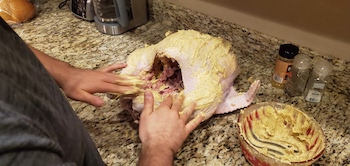 One: apply butter herb paste to under the skin and outside the skin on all parts of the bird possible.
One: apply butter herb paste to under the skin and outside the skin on all parts of the bird possible.
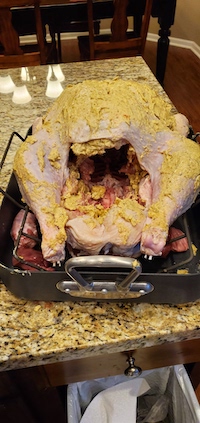 Two: Place the buttered turkey on the rack and all the turkey extra parts in the tray below (giblets, heart, kneck etc).
Two: Place the buttered turkey on the rack and all the turkey extra parts in the tray below (giblets, heart, kneck etc).
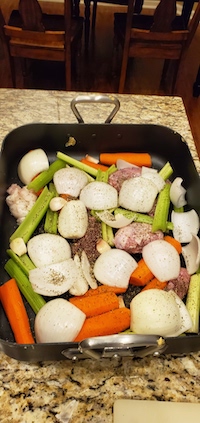 Three: place the vegatables in the lower tray with the turkey extras.
Three: place the vegatables in the lower tray with the turkey extras.
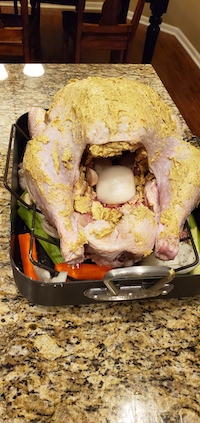 Four: add the onions, garlic and celery to the bird cavity
Four: add the onions, garlic and celery to the bird cavity
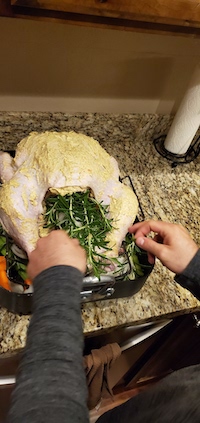 Five: add Rosemary sprigs to turkey cavity and to the tray as well.
Five: add Rosemary sprigs to turkey cavity and to the tray as well.
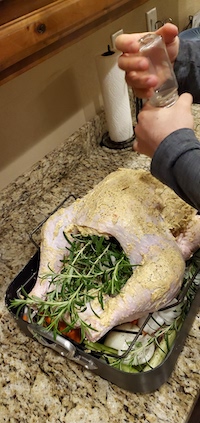 Six: grind fresh pepper over the final prepped bird.
Six: grind fresh pepper over the final prepped bird.
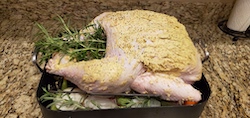 Seven: The turkey is now prepped (evening before).
Seven: The turkey is now prepped (evening before).
Eight: (on the day of the eating/cooking) Add a half lemon to the turkey cavity (cut twice) and pour the chicken stock liquid into the bottom of the tray. Cook the turkey for the appropriate number of hours.
Important Notes
- The USDA recommends that you heat a turkey to 165oF minimum temperature for food safety. The purpose of this article is to record my own personal experience cooking turkey, and not to recommend or affirm the safety of the method I have set forth here. You should cook your food responsibly and use caution.

